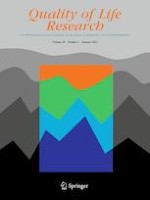12-09-2020
Predictors for quality of life improvement after acute osteoporotic vertebral fracture: results of post hoc analysis of a prospective randomized study
Gepubliceerd in: Quality of Life Research | Uitgave 1/2021
Log in om toegang te krijgenAbstract
Purpose
No study has investigated the clinical and radiographic risk factors for the deterioration of quality of life (QOL) beyond 6 months after osteoporotic vertebral fractures (OVF). The purpose of this study was to identify the predictors associated with poor QOL improvement after OVF.
Methods
This post hoc analysis included 166 women aged 65–85 years with acute 1-level OVFs. For the patient-reported outcome measures, scores on the European Quality of Life-5 Dimensions (EQ-5D) scale, and visual analogue scale (VAS) for low back pain were used. Lateral radiography at 0, 12, and 48 weeks and magnetic resonance imaging (MRI) at enrollment and at 48 weeks were performed. The associations between baseline variables with change scores for EQ-5D were investigated using a multiple linear regression model.
Results
Univariate analysis showed that time since fracture, EQ-5D score, and VAS for low back pain at 0 week showed significant association with increased EQ-5D score from 0 to 48 weeks. According to the multiple regression analysis, the following equation was obtained: increased EQ-5D score from 0 to 48 weeks = 1.305 – 0.978 × EQ-5D at 0 week – 0.021 × VAS for low back pain at 0 week – 0.006 × age + (fluid-intensity T2-weighted MR image patterns: − 0.037, except for fluid-intensity T2-weighted MR image patterns: + 0.037).
Conclusion
In conclusion, older patients with severe low back pain and fluid-intensity T2-weighted MR image patterns were more likely to have lower QOL improvements after OVFs and may therefore need extra support to improve QOL
